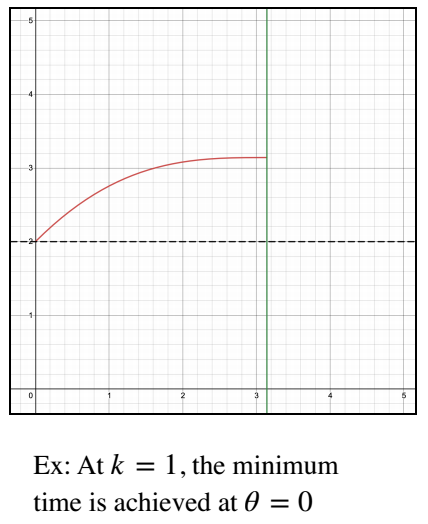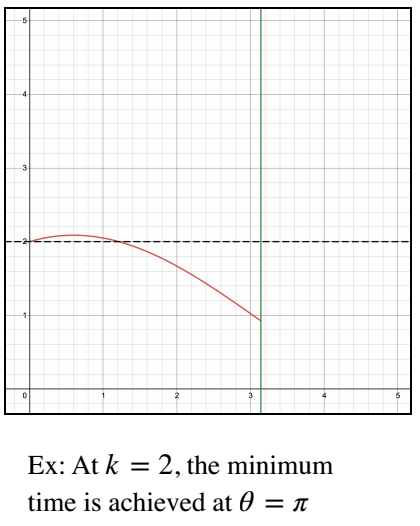Or search by topic
Number and algebra
Geometry and measure
Probability and statistics
Working mathematically
Advanced mathematics
For younger learners
To Swim or to Run?



- Problem
- Getting Started
- Student Solutions
- Teachers' Resources
Well done to Mahdi from Mahatma Gandhi International School in India who sent in this thorough solution:
Swimming Speed: 1
Running Speed: $k$
Radius of pool: $1$
(i) Case 1 (swim directly to B) is covered in this diagram when $\theta = 0$
(iii) Case 3 is covered in this diagram when $\theta = \pi$
Running Distance: arc AX which has length $\dfrac{\theta}{2\pi}\times 2\pi r = \theta r$
Running Time: $\dfrac{\theta r}k$ because the running speed is $k$
Swimming Distance: Chord $\text{XB}$ which has length $\text{2XM.}$ $\angle\text{XOM}=90-\frac{\theta}2$
Why $90-\frac{\theta}2$? $\angle\text{BOX}$ and $\theta$ lie on a straight line. $\angle\text{BOX}$ is in an isosceles triangle with $\angle\text{OBX}$ and $\angle\text{OXB,}$ therefore $\angle\text{OBX}$ and $\angle\text{OXB} = \angle\text{OXM}$ are both equal to $\dfrac{\theta}2.$ Triangle $\text{OMX}$ is right-angled at $\text{M.}$
$$\begin{align}\sin{\left(90-\frac{\theta}2\right)}&=\frac{\text{XM}}{\text{OX}}\\ \text{XM}&=r\cos{\left(\frac \theta 2 \right)}\\ \text{XB} &= 2r\cos{\left(\frac \theta 2 \right)}\end{align}$$
Swimming Time: $\dfrac{2r\cos{\left(\dfrac \theta 2 \right)}}1 = 2r\cos{\left(\dfrac \theta 2 \right)}$
So, total time, $T$ = Running Time + Swimming Time $$ T = \dfrac{\theta r}k + 2r\cos{\left(\dfrac \theta 2 \right)}$$
To find the minimum time, $\dfrac{\text d T}{\text d \theta}=0$ and $\dfrac{\text d^2 T}{\text d \theta^2}\gt0$ $$\begin{align}\dfrac{\text d T}{\text d \theta}&=\frac r k - 2r\sin{\left(\frac\theta2\right)}\times\frac12\\ &=r\left[\frac1k-\sin{\left(\frac\theta2\right)}\right]\end{align}$$
Now the double derivative has to be positive for there to be a minimum $$\begin{align}\dfrac{\text d^2 T}{\text d \theta^2} &= r\left[0-\cos{\left(\frac\theta2\right)}\times\frac12\right]\\ &=\frac{-r}2\cos{\left(\frac\theta2\right)}\end{align}$$
For $0\le\theta\le\pi,$ $\cos{\left(\frac\theta2\right)}\ge0$ and so $\dfrac{\text d^2 T}{\text d \theta^2}\le0$ which implies there is no minimum time between $0\le\theta\le\pi.$ Hence, the minimum is at either of the end points. There are two cases for that, as shown in the two graphs below. $r,$ the radius of pool, just adds vertical stretch.


There is a value of $k$ for which the time taken at $\theta = 0$ is equal to the time taken at $\theta = \pi.$ And the time taken is $2$ for both [times $r$]. Let $r=1$ since it just adds vertical stretch to the graph.
For this value of $k,$ running all the way ($\theta = \pi$) takes time $2$ (the same amount of time that swimming all the way takes). $$2=\frac{\theta}{k}+2r\cos{\left(\frac{\theta}2\right)}\\ 2=\frac{\pi}{k}+2r\cos{\left(\frac{\pi}2\right)} \\ 2=\frac{\pi}{k}$$ So we get $k = \dfrac \pi2$. We can thus conclude that:
For $0\lt\theta\lt\dfrac\pi2,$ the minimum time is achieved at $\theta = 0.$ So option (i) swim directly.
For $\dfrac\pi2\lt\theta\lt\pi,$ the minimum time is achieved at $\theta = \pi.$ So option (iii) run around.
You may also like
Curvy Equation
This problem asks you to use your curve sketching knowledge to find all the solutions to an equation.
Digital Equation
Can you find a three digit number which is equal to the sum of the hundreds digit, the square of the tens digit and the cube of the units digit?
Euler's Totient Function
How many numbers are there less than $n$ which have no common factors with $n$?

